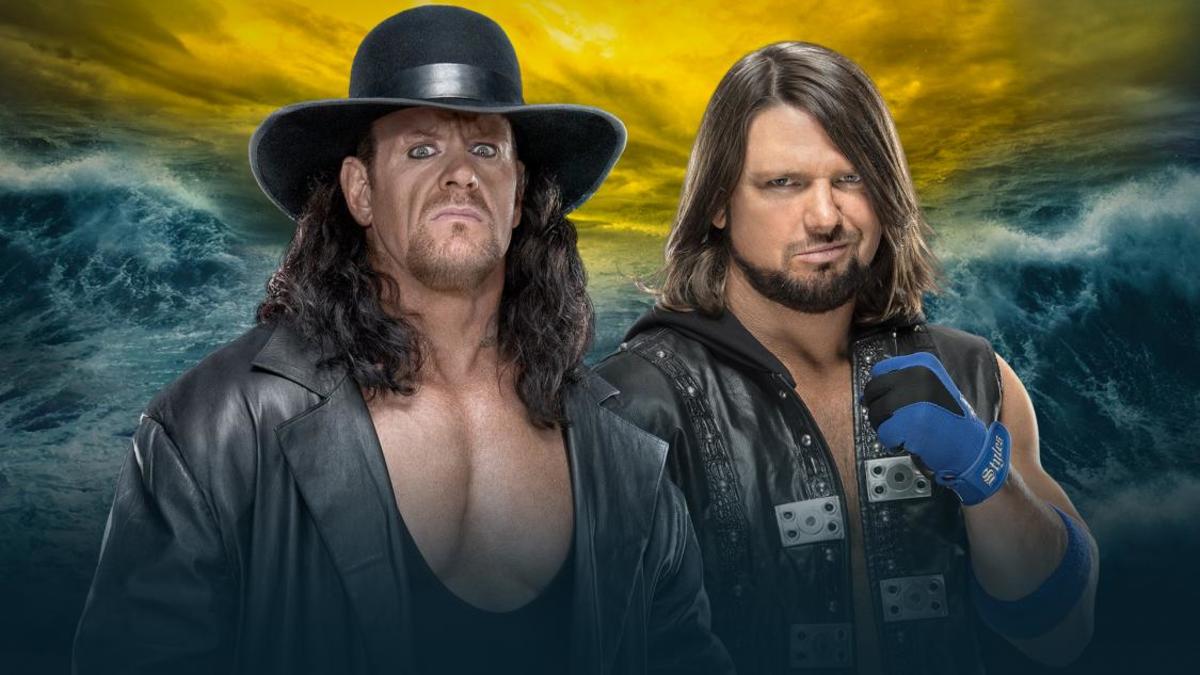Bruce Prichard on The Undertaker: 'Without a Doubt, He’s the Greatest Creation Ever in WWE’
When The Undertaker was introduced at the Survivor Series in 1990, he was led to the ring by Brother Love.
Brother Love is Bruce Prichard, a longtime Vince McMahon associate and current WWE executive in the role of Executive Director of Friday Night SmackDown. Thirty years ago, Prichard played a critical role in bringing The Undertaker to WWE.
Beginning with his work in the Dallas territory in '87, Prichard became enamored with the size and athleticism of Mark Calaway. In '90, Calaway's then-manager Paul Heyman made a fateful call to Prichard, asking if there was any interest in Calaway for the World Wrestling Federation. Prichard wanted McMahon to sign Calaway. Initially, McMahon was not interested, which remained the case after watching Calaway’s '90 match against Lex Luger from The Great American Bash. McMahon eventually agreed to meet in-person, which was when he recognized the untapped potential in Calaway. Soon after, The Undertaker was created, with Prichard as his Dr. Frankenstein.
Before chapter two of the Last Ride documentary airs on the WWE Network this Sunday, Prichard spoke with Sports Illustrated, discussing managing The Undertaker, the character's place among the greatest ever created in WWE, and the relationship between Vince McMahon and The Undertaker.
Justin Barrasso: Why were you the right fit to manage The Undertaker in 1990?
Bruce Prichard: The original concept was a yin to the yang of Brother Love, who was this pure as snow evil character. The Undertaker was a character in my head to be that evil, that darkness. And there is a bit of a biblical theme, as the first person to ever commit murder was Cain when he murdered his brother Abel. That was why we introduced the character as Kane The Undertaker. The fact he was portrayed as this truly evil character was the perfect complement for Brother Love.
Barrasso: Mark Calaway is incredibly talented, but he struggled to find success in pro wrestling until he became The Undertaker. Was this a situation where talent and hard work aligned with perfect timing?
Prichard: Timing is everything. When Mark Calaway started out in Dallas, I used to receive tapes of his work. What initially attracted him to me was how he walked the ropes. For a big man, he was so agile and such a tremendous athlete.
Mark Calaway had an intangible when he walked into the ring, that it-factor. He had a desire to improve and a true love for his performance. I watched him in Dallas and I watched him in WCW. So when WCW wasn’t doing anything with him and his contract came up, that’s when Paul Heyman gave me a call and said Mark was ready to make a move.
Vince wasn’t totally enamored with him from watching him on TV. But it was that first face-to-face meeting and conversation that convinced him otherwise. The rest, as they say, is history.
Barrasso: Was it ever possible to manage The Undertaker and work in the office?
Prichard: It wasn’t fair to the package of The Undertaker. I needed to choose whether I wanted to be in the office or on the road all the time, and I chose to be in the office because I thought that’s where the longevity was for me.
But talk about timing. When Paul Bearer came into the office to interview, we’d always ask people to speak a little bit about themselves and their interests. His revelation was that he was a licensed mortician. Paul fell right into our lap, and it was a perfect match. They fit each other so well, and Paul, actually as Percy Pringle, was Undertaker’s first manager in Dallas.
Barrasso: You can’t think of Taker without Paul Bearer. How integral was that pairing to the success of The Undertaker?
Prichard: Especially early on, The Undertaker wouldn’t have done as well without Paul Bearer. That’s because of the interviews and the promos. Taker has become a great promo, but he wasn’t at the time.
Barrasso: Part of that early Undertaker allure was that he didn’t speak much beyond “Rest in peace.”
Prichard: Paul Bearer added to that mystique since he was the one telling The Undertaker’s story. There was so much more mystery surrounding The Undertaker because you only got a few words out of him. “Rest in peace,” that was about it. The audience wanted to hear more, but he wouldn’t let you in all the way. Paul Bearer was that conduit to tell The Undertaker’s story.
Barrasso: Chapter two of the Last Ride documentary details the relationship between The Undertaker and Vince McMahon. You know both men very well. What is a memory of yours that captures the Taker/Vince relationship?
Prichard: Taker talks about this in the documentary, and it still sticks out to me, the way he would prepare for a meeting with Vince. Taker would often use me as a sounding board for whatever grievance or issue he may have had at the time, and he’d tell me he was going into Vince’s office and he was going to change this or that. He’d walk in all fired up, then walk out shaking his head. You could tell that, as soon as Vince started to speak, he’d cast a spell over Taker. Mark would end up walking out of the meeting with Vince, loving whatever idea he hated walking in.
Barrasso: Wrestling is subjective and it would be impossible to ask people to agree on its greatest star, but is The Undertaker the WWE’s greatest creation?
Prichard: Without a doubt, he’s the greatest creation ever in WWE. Second is Kane. They had a deep, good story behind them, and both of the men that portray those characters are those characters. Mark Calaway became The Undertaker, and Glenn Jacobs became Kane. That’s how seriously they took their craft. You’d watch them and believe them. The Undertaker and Kane, both of those were beautiful matches.
Barrasso: You have been enamored with wrestling since your time watching Paul Boesch’s territory in Houston. The Undertaker has had some many wonderful moments in WWE. What is your favorite Undertaker storyline?
Prichard: By far, the revelation that The Undertaker had a brother named Kane. Revealing that family’s background with the fire, thinking his brother was dead, realizing he was alive, that story ended up lasting all these years. It was initially only meant to be a storyline because we needed an opponent for The Undertaker. That’s why we created Kane. But the story had so many layers that we were able to create a brand-new character that could go off and succeed on his own, yet still come back to the family story. They were great adversaries and they were great partners, and that story has lasted and endured this entire time. For me, hands down, that’s my favorite Undertaker story.
Barrasso: Plus, it’s evolved so much from where it began, which is a big part of The Undertaker’s success.
Prichard: That’s the magic of The Undertaker. When you watch this documentary, you get to see the man behind the character in Mark Calaway. He was able to tell this story and be this character for all these years. That’s the true success.
The beauty of this documentary is learning the story behind the character, hearing about that relationship with Vince and how all of this evolved. He wasn’t just the old-school Undertaker in the long trench coat. He went to the leather, went to the tear-drop, which I called his pirate stage. Then he became the ‘American Badass,’ then back to the Dead Man. The way this character has evolved is magical, and that’s why it has endured.
Barrasso: Are you surprised that Mark agreed to do the documentary?
Prichard: Yes and no. The reason I say that is, every year at WrestleMania, even when I wasn’t with the company, I would send him a good luck text and check on him after the match. Every year, I would get the same response, telling me that match was the last one. I’d send back, every year, ‘We’ll have this talk next year,’ which we did.
So I wasn’t surprised. Mark felt it was the right time for this, and it is. You want to be able to document him while he’s still feeling good and healthy. This is also the right thing to do for the fans out there that grew up with him and want to see this.
Barrasso: On the subject of WrestleMania, in terms of presentation, was the finished product of the “Boneyard” match the best-case scenario for The Undertaker?

Prichard: The presentation and the entire story, everything about it, I absolutely loved. It was a way to highlight the character of The Undertaker and AJ Styles, and put them in the very best light possible. Unfortunately, we didn’t have a stadium to play into it, but they made this high-profile match unique unto itself. To me, that was a success. The Undertaker had the opportunity to showcase his talent in a completely different way. It couldn’t have been better in my eyes.
Barrasso: What is something viewers will learn about The Undertaker from watching the Last Ride doc?
Prichard: Behind that persona, there is a human being. The Undertaker is this larger-than-life character, but you get a different sense in the documentary. More than anything, you get to see Mark Calaway as a man and a family man. So you come away with a better appreciation of the man and the way he built the character.
Justin Barrasso can be reached at JBarrasso@gmail.com. Follow him on Twitter @JustinBarrasso.
